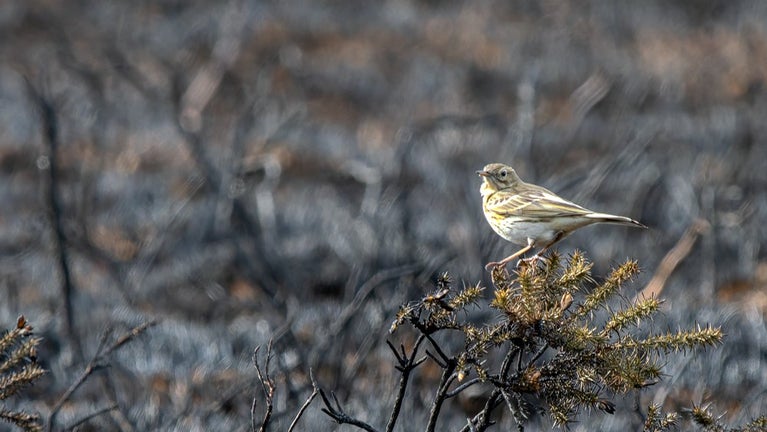Birds, beetles and butterflies: conservationists reveal wildlife affected by UK fires
- Published:
- 16 April 2025
- Last updated:
- 16 April 2025

The National Trust has laid bare some of the varied species of wildlife that have been affected by this month’s spate of wildfires.
After the driest March in decades, and warmer than average temperatures in April, the UK has had one of the worst fire seasons on record.
Fires in recent weeks have included one spanning 1,600 hectares – roughly 400 times the size of Cardiff’s Principality Stadium – at the National Trust’s Abergwesyn Common in Powys, Mid Wales. The blaze damaged vast areas of prime habitat for small mammals and birds, and rangers fear that breeding habitat of the area’s last known population of golden plovers, a rare upland species, will have been lost.
Chris Smith, the National Trust’s Countryside Manager for Mid and South Wales said: "The sheer scale of the fire on Abergwesyn Common is hard to fathom. As a Site of Special Scientific Interest (SSSI), the impacts on wildlife are widespread, with birds' nests, insects, amphibians and reptiles all scorched by fire. Whole ecosystems have been decimated and will remain altered well into the future.
"Alongside this, the huge loss of surface vegetation leaves the peat bogs we have been working hard to restore and rewet vulnerable to erosion and at further risk of fire and carbon loss. Where the flames burnt down to the peat soils, they will take hundreds of years to recover."
Meanwhile in the Mourne Mountains in Northern Ireland, recent fires have scorched land used by a whole array of wildlife, including grayling and small heath butterflies, rove beetles, skylarks and even peregrine falcons. Smaller birds such as skylarks rely on the insects and beetles for food, with these birds in turn providing a food source for larger birds of prey.
The Mournes are home to the only native lizard in Northern Ireland, the viviparious lizard. And in spring, the area welcomes wheatears, which make the journey from Africa to breed and are reliant on insects to feed. Monitoring after a major fire in the area in 2021 showed a significant impact on the diversity and abundance of wildlife species.
On Trust land on Exmoor, photos taken by rangers show meadow pipits and slow worms hunting on charred ground, after a 45-hectare fire last month.
In some places, the blazes have ruined years’ worth of conservation efforts. At Howden Moor, in the Peak District, the National Trust said a recent fire that stretched for two kilometres had caused £30,000 worth of damage.
At many sites, fire services are still investigating the causes of the incidents.
The Trust is adapting its landscapes by making big tracts of land wetter and boggier, including by planting special mosses that hold water and by creating wetlands that, once established, act like natural fire breaks.
The charity is also calling on policymakers to make climate adaptation a bigger cross-Government focus.
Ben McCarthy, the Trust’s head of nature conservation, said: “While the arrival of sunny weather was a cause for celebration for many, for some of our countryside teams, and of course for our fire services, it’s been a very tough few weeks.
“The vast majority of fires in the UK are started by people – whether accidentally or not – rather than by natural causes. So while we want everyone to enjoy the outdoors, we’re calling on people to be responsible as even a small spark can cause a fire. Please call 999 if you see a fire or any suspicious behaviour.
“As well as greater public education and engagement, as the climate gets hotter, we also need urgent Government action to help the UK mitigate and adapt to this and the many other climate risks facing our cherished yet threatened landscapes.”
People can donate to the National Trust’s climate action appeal to support vital conservation work that is needed to ensure landscapes can become resilient to flooding, wildfires and extreme temperatures: https://www.nationaltrust.org.uk/support-us/appeals/climate-appeal